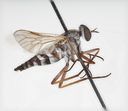Stiletto Flies
Therevidae
Classification
- Phylum: Arthropoda
- Subphylum: Hexapoda
- Class: Insecta
- Order: Diptera
- Superfamily: Asiloidea
- Family: Therevidae
Pronunciation
How to pronounce Therevidae: /ˈθɛrəvɪdiː/
These audio files are automatically generated. While they are not always 100% accurate, they are a good starting point.
Images






Summary
Therevidae is a family of flies known as stiletto flies, containing about 1,600 species worldwide. They are predators in their larval stage and nectar feeders as adults. They inhabit diverse environments, favoring arid and sandy areas.
Physical Characteristics
Adult Therevidae are small- to medium-sized with a body length of 2.4 to 18 mm and a hairy integument. The coloration ranges from shades of yellow to black, commonly masked by tomentum. Males generally have larger compound eyes, often holoptic, while females have well-developed dichoptic eyes. The thorax is broad and moderately convex with long bristles. The abdomen is tapered and elongated, typically 3 to 4 times as long as its broadest point. Wings are well developed, hyaline or opaque, and the wing venation is complex but not uniquely distinguishing.
Identification Tips
The scape of antennae is elongated, with a very short pedicel and a conical first flagellomere. The labium has two fleshy labella, and setae near the mouthparts are fluffy rather than stiff bristles unlike in Asilidae. The larvae are apodous, smooth, white or pink, cylindrical and very thin.
Habitat
Adults are typically found in open areas including streams, meadows, open woodlands and sandy grounds or beaches. Larvae are found in sandy soils and decaying organic matter.
Distribution
Globally, Therevidae are represented in all zoogeographical regions. The Therevinae are found on all continents; Phycinae occur in the Afrotropical and Holarctic regions; Xestomyzinae are mainly Afrotropical; Agapophytinae are endemic to the Australasian realm.
Diet
Adults primarily feed on nectar, honeydew, and pollen, while larvae are predators on soil arthropods and various insect larvae.
Life Cycle
The lifecycle generally consists of one generation per year, with some European species having cycles of two or more years. The overwintering stage is the mature larva, and the overall lifecycle includes five instars before pupation in spring.
Reproduction
Reproductive habits are not extensively documented; however, oviposition is likely linked to sandy or decaying organic substrates.
Ecosystem Role
The larvae act as predators within soil ecosystems, controlling populations of insect larvae, while adults contribute to pollination.
Evolution
The Therevidae family is a monophyletic clade known as the therevoid clade, characterized by complex taxonomic history and revisions, especially since the 1970s.
Similar Taxa
- Asilidae
- Brachycera
Misconceptions
Larvae may be mistaken for potworms or earthworms due to their long and serpentine appearance.
Tags
- Diptera
- Insecta
- Therevidae
- Stiletto Flies
- Predatory Larvae